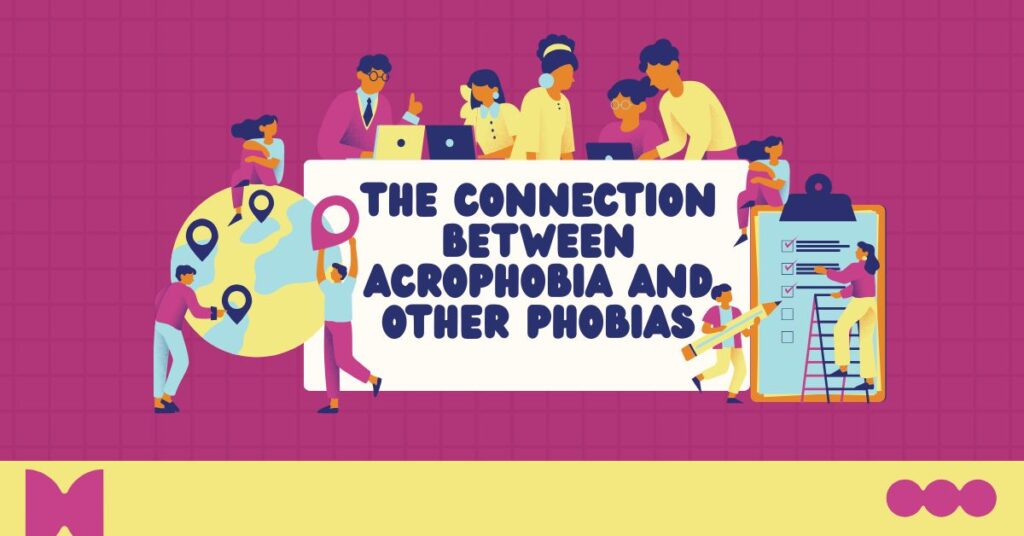Acrophobia, the fear of heights, affects many people. But how does it relate to other phobias?
Understanding the link between acrophobia and other phobias can offer deeper insights into the nature of fear. Many phobias often share common triggers and symptoms. This means that if you suffer from one phobia, you might be more likely to develop others.
The brain’s response to fear can be complex, leading to overlapping anxieties. Exploring these connections helps in finding better ways to manage and treat these fears. This post will delve into how acrophobia is connected to other phobias, shedding light on the underlying patterns that tie them together. Let’s uncover these links and understand fear better.
Topic of Contents
ToggleAcrophobia Explained
Acrophobia, the fear of heights, affects many people worldwide. This fear can be overwhelming and disrupt daily life. It often links to other phobias, creating a complex web of fears. Understanding acrophobia helps in managing and overcoming it.
Definition And Symptoms
Acrophobia is the irrational fear of heights. It triggers intense anxiety and panic. This phobia can cause physical symptoms, such as sweating, shaking, and dizziness. Some people may experience nausea or a racing heart. Fear may arise even at small heights, like standing on a chair.
Common Triggers
Various situations can trigger acrophobia. Looking out from tall buildings is a common trigger. Climbing ladders or standing on balconies can also cause fear. Even watching scenes of heights in movies may trigger anxiety. Each person may have unique triggers based on personal experiences.
Types Of Phobias
Phobias are intense and irrational fears of specific objects, situations, or activities. These fears can affect anyone and often lead to avoidance behavior. Understanding the different types of phobias can help in recognizing and managing them.
Specific Phobias
Specific phobias are intense fears of particular objects or situations. Common examples include fear of heights (acrophobia), spiders (arachnophobia), and flying (aviophobia). These fears are usually disproportionate to the actual danger posed by the object or situation. Specific phobias often develop in childhood and can persist into adulthood.
Complex Phobias
Complex phobias are more disabling and often develop during adulthood. These include agoraphobia and social phobia. Agoraphobia involves a fear of being in situations where escape might be difficult. Social phobia, or social anxiety disorder, is the fear of social situations. People with complex phobias may avoid everyday activities, impacting their quality of life.
Psychological Factors
Acrophobia, the fear of heights, often intertwines with other phobias. Various psychological factors contribute to this connection. These factors include genetics, the environment, and personal experiences. Understanding these elements can help in managing and treating acrophobia and related phobias.
Genetic Influence
Genetics play a significant role in the development of acrophobia. Studies show that phobias can run in families. If your parents or siblings have acrophobia, you might have a higher chance of experiencing it too. This genetic predisposition often overlaps with other phobias, suggesting a shared genetic base.
| Phobia | Genetic Link |
|---|---|
| Acrophobia | High |
| Claustrophobia | Medium |
| Agoraphobia | Medium |
Environmental Factors
The environment also influences the development of acrophobia. Traumatic experiences, such as a fall from a height, can trigger this fear. Childhood experiences significantly impact the likelihood of developing acrophobia. For example, witnessing a traumatic event related to heights can instill a lifelong fear.
- Past traumas
- Parental influence
- Social learning
Environmental factors contribute to a complex interplay between acrophobia and other phobias. Social learning, where individuals learn fears by observing others, also plays a crucial role. For instance, seeing a family member express fear of heights can lead to developing the same fear.
Acrophobia And Anxiety
Acrophobia, or fear of heights, is a specific phobia that can greatly impact one’s life. This fear can trigger severe anxiety, leading to physical symptoms and emotional distress. Understanding the connection between acrophobia and anxiety can help in managing both conditions effectively.
Link To General Anxiety Disorder
Acrophobia often links to General Anxiety Disorder (GAD). Individuals with GAD experience persistent and excessive worry. This constant state of anxiety can amplify the fear of heights. The thought of being at a high place can cause extreme nervousness. This reaction is often out of proportion to the actual danger.
People with GAD may find it hard to control their anxiety. Their fear may extend beyond heights to other situations. This overlap of fears can create a complex web of anxiety disorders. Managing one phobia can sometimes help alleviate the symptoms of the other.
Impact On Daily Life
Acrophobia and anxiety can severely impact daily life. Simple tasks can become overwhelming. For instance, climbing stairs or crossing bridges may induce panic. This can limit one’s ability to work, socialize, or even travel.
The constant fear and anxiety can lead to avoidance behaviors. People may avoid situations where they might encounter heights. This can restrict their activities and lower their quality of life. Additionally, the stress from this avoidance can cause further mental health issues.
Understanding the link between acrophobia and anxiety is crucial. It can guide effective treatment and improve overall well-being.
Common Comorbid Phobias
Acrophobia, the fear of heights, often coexists with other phobias. This phenomenon is known as comorbidity. Understanding these common comorbid phobias can help in managing acrophobia more effectively.
Claustrophobia
Claustrophobia is the fear of enclosed spaces. It is a common comorbid phobia with acrophobia. Individuals with acrophobia may also fear elevators, small rooms, or crowded places. This overlap can make certain situations extremely challenging. For example, someone might fear both the height of a skyscraper and the elevator ride to reach the top.
Managing both phobias requires a comprehensive approach. Techniques such as cognitive-behavioral therapy (CBT) and gradual exposure can be effective. Here are some strategies:
- Relaxation techniques: Deep breathing and meditation can help.
- Gradual exposure: Slowly facing the feared situations can reduce anxiety.
- Professional help: Therapists can provide structured support.
Agoraphobia
Agoraphobia involves the fear of open or crowded spaces. It often overlaps with acrophobia. People with both phobias may avoid places like malls, parks, or public events. This avoidance can limit daily activities and social interactions. It’s important to address both phobias simultaneously to improve quality of life.
Effective management strategies for agoraphobia include:
- Exposure therapy: Gradually facing feared situations.
- Cognitive restructuring: Changing negative thought patterns.
- Support groups: Sharing experiences with others who understand.
Understanding these common comorbid phobias can provide a clearer path to overcoming acrophobia. With the right strategies, individuals can regain control and lead fulfilling lives.
Case Studies
Case studies offer valuable insights into the connection between acrophobia and other phobias. Each story reveals unique experiences and outcomes. These real-life examples highlight how intertwined fears can impact daily life. They also show how therapy can help manage multiple phobias. Let’s explore some patient experiences and their therapeutic outcomes.
Patient Experiences
John, a 34-year-old, suffers from acrophobia and claustrophobia. His fear of heights makes it hard to use elevators. He also avoids tall buildings. His fear of enclosed spaces complicates his life further. He often feels trapped and anxious. This combination of fears limits his job options. It also affects his social life. John’s case shows how multiple phobias can intertwine.
Lisa, a 28-year-old, has acrophobia and social phobia. She avoids high places and large gatherings. This makes attending events difficult. Lisa’s fear of heights prevents her from enjoying vacations. Her social phobia limits her interactions. She often feels isolated and anxious. Lisa’s experiences show the overlap of different fears.
Therapeutic Outcomes
John started cognitive-behavioral therapy (CBT). His therapist used exposure therapy. John gradually faced his fears. He began with small steps. Over time, he used elevators and visited tall buildings. His anxiety reduced significantly. John now manages his fears better. His therapy improved his quality of life.
Lisa also tried CBT. Her therapist combined exposure therapy with social skills training. Lisa practiced facing her fears in controlled settings. She attended small gatherings and gradually larger events. Lisa also visited higher places with support. Her therapy helped reduce her anxiety. She now feels more confident in social and high places.
These case studies show the effectiveness of therapy. They highlight how addressing multiple phobias can improve lives. Each patient found relief through structured therapy plans.
Treatment Options
Acrophobia, the fear of heights, often coexists with other phobias. Treating these phobias together can lead to better outcomes. Effective treatment options include Cognitive Behavioral Therapy (CBT) and Exposure Therapy. Let’s explore these methods in detail.
Cognitive Behavioral Therapy
Cognitive Behavioral Therapy (CBT) is a common approach for treating phobias. It helps individuals understand and change their thought patterns and behaviors. In CBT, you work with a therapist to identify negative thoughts. You learn to replace them with positive, rational thoughts.
CBT often involves:
- Identifying triggers
- Challenging irrational beliefs
- Learning coping skills
This therapy can reduce anxiety and improve daily life. It is effective for many types of phobias, including acrophobia.
Exposure Therapy
Exposure Therapy is another effective method. It involves gradual exposure to the feared object or situation. The goal is to reduce the fear response over time.
Exposure Therapy typically includes:
- Creating a fear hierarchy
- Starting with less frightening situations
- Gradually facing more challenging scenarios
This method helps in building confidence. You learn that you can handle the fear. Exposure Therapy is useful for both acrophobia and other related phobias.
Coping Strategies
Acrophobia often links with other phobias, such as claustrophobia and agoraphobia. Understanding these connections can help in developing effective coping strategies.
Coping with acrophobia and other phobias can be challenging. Implementing effective strategies helps manage these fears, making daily life more manageable. Here are some practical techniques to consider.
Mindfulness Techniques
Mindfulness techniques help people stay grounded. Focus on the present moment to reduce anxiety. Deep breathing exercises are a good start. Breathe slowly in and out, counting to four. This calms the mind and body. Progressive muscle relaxation also helps. Tense and then relax each muscle group. Start from your feet and work up to your head. This reduces physical tension caused by fear. Visualization is another helpful tool. Picture a calm, safe place in your mind. Imagine every detail clearly. This distracts from fear and promotes relaxation.
Support Systems
Support systems play a key role in managing phobias. Family and friends can provide comfort. Share your fears with them. They can offer understanding and encouragement. Joining a support group is also beneficial. Connect with others who face similar challenges. Share experiences and coping strategies. This creates a sense of community and reduces feelings of isolation. Professional help should not be overlooked. Therapists can offer specialized techniques. Cognitive-behavioral therapy is effective for many. It helps reframe negative thoughts and behaviors.
Future Research Directions
The connection between acrophobia and other phobias presents a rich field for research. Understanding these links could pave the way for better treatments. Future research directions offer exciting possibilities for those affected by these fears.
Innovative Therapies
Researchers are exploring new therapies to treat acrophobia and related phobias. Virtual reality exposure therapy shows promise. Patients can face their fears in a controlled setting. This method reduces anxiety and improves coping skills.
Another approach is cognitive-behavioral therapy (CBT). CBT helps patients change negative thought patterns. This technique is effective for various phobias. Combining CBT with virtual reality could enhance treatment outcomes.
Medication is also under study. Some drugs may help reduce phobia symptoms. Researchers aim to find the most effective options. Innovative therapies could offer relief to many people.
Long-term Studies
Long-term studies are crucial to understanding phobias fully. Researchers need to track patients over time. This helps identify patterns and triggers.
Long-term studies can reveal how phobias change with age. They also show the effectiveness of different treatments over years. This information is vital for developing lasting solutions.
Data from long-term studies can guide future research. Researchers can focus on the most promising areas. This ensures resources are used effectively.
Understanding the connection between acrophobia and other phobias requires comprehensive research. Innovative therapies and long-term studies will play a key role. These efforts could lead to better treatments and improved quality of life for those affected.
Frequently Asked Questions
What Is Acrophobia?
Acrophobia is an intense fear of heights. It can cause panic attacks and avoidance behaviors. This phobia can significantly impact daily activities and quality of life.
How Is Acrophobia Diagnosed?
Acrophobia is diagnosed through a detailed psychological evaluation. Mental health professionals assess symptoms and history. They may use questionnaires and interviews to confirm the diagnosis.
Can Acrophobia Be Treated?
Yes, acrophobia can be treated. Common treatments include cognitive-behavioral therapy (CBT) and exposure therapy. Medications may also help in managing symptoms.
Are Acrophobia And Vertigo Related?
Acrophobia and vertigo are different. Acrophobia is a fear of heights, while vertigo is a sensation of spinning. Both can coexist in some individuals.
Conclusion
Understanding acrophobia helps in recognizing other related phobias. Many fears share similar triggers. Identifying these connections can aid in better treatment. Awareness of these links can reduce stigma. People can seek help knowing they are not alone. Addressing one fear may help ease others.
Always consult a professional for phobia-related concerns. Overall, knowledge empowers us to manage our fears better. Stay informed, stay healthy.







